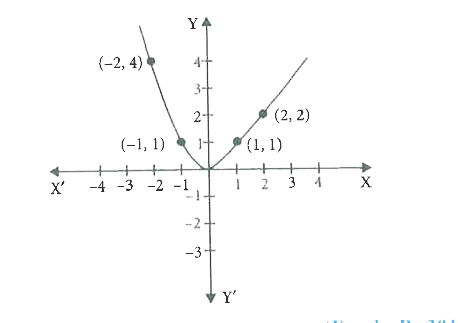The function f whose graph passes through (4, - 20) and whose derivative is cos(√4−x) is given by
√4−xsin√4−x+(4−6x)cos√4−x
√4−xsin√4−x+√4−xcos√4−x−20
−2(√4−xsin√4−x+cos√4−x)−18
−(2x+12)√4−xsin√4−x+(4−6x)cos√4−x
The correct Answer is:D
To find the function f whose graph passes through the point (4,−20) and whose derivative is f′(x)=cos(√4−x), we will follow these steps:
Step 1: Set up the integral
We know that f′(x)=cos(√4−x). To find f(x), we need to integrate f′(x):
f(x)=∫cos(√4−x)dx
Step 2: Use substitution
Let t=√4−x. Then, we can express x in terms of t:
x=4−t2
Now, differentiate both sides with respect to x:
dx=−2tdt
Step 3: Substitute in the integral
Substituting t and dx into the integral, we have:
f(x)=∫cos(t)(−2t)dt=−2∫tcos(t)dt
Step 4: Apply integration by parts
Using integration by parts, where we let:
- u=t (thus du=dt)
- dv=cos(t)dt (thus v=sin(t))
Now, apply the integration by parts formula:
∫udv=uv−∫vdu
This gives us:
−2(tsin(t)−∫sin(t)dt)
Calculating the integral of sin(t):
∫sin(t)dt=−cos(t)
Thus,
f(x)=−2(tsin(t)+cos(t))+C
Step 5: Substitute back for t
Now, replace t back with √4−x:
f(x)=−2(√4−xsin(√4−x)+cos(√4−x))+C
Step 6: Use the point to find C
We know that f(4)=−20:
f(4)=−2(√4−4sin(√4−4)+cos(√4−4))+C=−20
This simplifies to:
−2(0+1)+C=−20
−2+C=−20
C=−20+2=−18
Step 7: Write the final function
Substituting C back into the equation, we get:
f(x)=−2(√4−xsin(√4−x)+cos(√4−x))−18
Thus, the function f is:
f(x)=−2√4−xsin(√4−x)+cos(√4−x)−18
We know that f′(x)=cos(√4−x). To find f(x), we need to integrate f′(x):
f(x)=∫cos(√4−x)dx
Let t=√4−x. Then, we can express x in terms of t:
x=4−t2
Now, differentiate both sides with respect to x:
dx=−2tdt
Substituting t and dx into the integral, we have:
f(x)=∫cos(t)(−2t)dt=−2∫tcos(t)dt
Using integration by parts, where we let:
- u=t (thus du=dt)
- dv=cos(t)dt (thus v=sin(t))
∫udv=uv−∫vdu
This gives us:
−2(tsin(t)−∫sin(t)dt)
Calculating the integral of sin(t):
∫sin(t)dt=−cos(t)
Thus,
f(x)=−2(tsin(t)+cos(t))+C
Now, replace t back with √4−x:
f(x)=−2(√4−xsin(√4−x)+cos(√4−x))+C
We know that f(4)=−20:
f(4)=−2(√4−4sin(√4−4)+cos(√4−4))+C=−20
This simplifies to:
−2(0+1)+C=−20
−2+C=−20
C=−20+2=−18
Substituting C back into the equation, we get:
f(x)=−2(√4−xsin(√4−x)+cos(√4−x))−18
f(x)=−2√4−xsin(√4−x)+cos(√4−x)−18
Topper's Solved these Questions
- INDEFINITE INTEGRATIONBOOK - MCGROW HILL PUBLICATIONCHAPTER - INDEFINITE INTEGRATIONEXERCISE - EXERCISE (LEVEL 2 (SINGLE CORRECT ANSWER TYPE QUESTION ))
30 Videos
- INDEFINITE INTEGRATIONBOOK - MCGROW HILL PUBLICATIONCHAPTER - INDEFINITE INTEGRATIONEXERCISE - EXERCISE ( NUMERICAL ANSWER TYPE QUESTION )
15 Videos
- INDEFINITE INTEGRATIONBOOK - MCGROW HILL PUBLICATIONCHAPTER - INDEFINITE INTEGRATIONEXERCISE - EXERCISE ( CONCEPT-BASED (SINGLE CORRECT ANSWER TYPE QUESTIONS))
10 Videos
- HYPERBOLABOOK - MCGROW HILL PUBLICATIONCHAPTER - HYPERBOLAEXERCISE - QUESTION FROM PREVIOUS YEARS. B-ARCHITECTURE ENTRANCE EXAMINATION PAPERS
8 Videos
- INVERSE TRIGONOMETRIC FUNCTIONS BOOK - MCGROW HILL PUBLICATIONCHAPTER - INVERSE TRIGONOMETRIC FUNCTIONS EXERCISE - QUESTIONS FROM PREVIOUS YEARS. B-ARCHITECTURE ENTRANCE EXAMINATION PAPERS
3 Videos
Similar Questions
Knowledge Check
The function f whose graph passes through (0,7/3) and whose derivative is x√1−x2 is given by
Af(x)=(1/3)((1−x2)3/2+7)Bf(x)=(3/2)[sin−1x+6]Cf(x)=−(1/3)[(1−x2)3/2−8]Df(x)=−(23)[(1−x2^(3/2)−8]The function f whose graph passes through (π/4,0) and whose derivative is log(tanx)sinxcosx is given by
A(logtanx)2+π4B12(logcosx)2C12(logsinx)2D12(logtanx)2The function f whose graph passes through (0,0) and whose derivative is cos4x+sin4xcos2x−sin2x is given by
A14log∣∣∣1+tanx1−tanx∣∣∣+12sinxcosxBlog∣∣∣cosx+sinxcosx−sinx∣∣∣+sin2xClog∣∣∣cosx−sinxcosx+sinx∣∣∣+12sinxcosx+xDnone of these
Find the equation of the circle passing through the points (4, 1) and (6, 5) and whose centre is on the line 4x+y=16.
View SolutionFind the equation of the circle which passes through the points (1,−2),(4,−3) and whose center lies on the line 3x+4y=7.
View SolutionThe function f whose graph passes through the point (0,7/3) and whose derivative is f'(x)=x√1−x2 is given by
View SolutionThe function f whose graph passes through (0,73) and whose derivatives of f(x)=ex dfffer by 2 the difference of these anti - derivatives at x = 100 is :
View SolutionA function whose graph is symmetrical about y-axis is
View Solution

